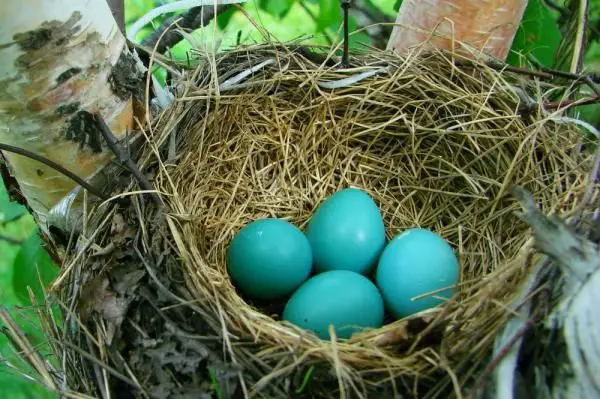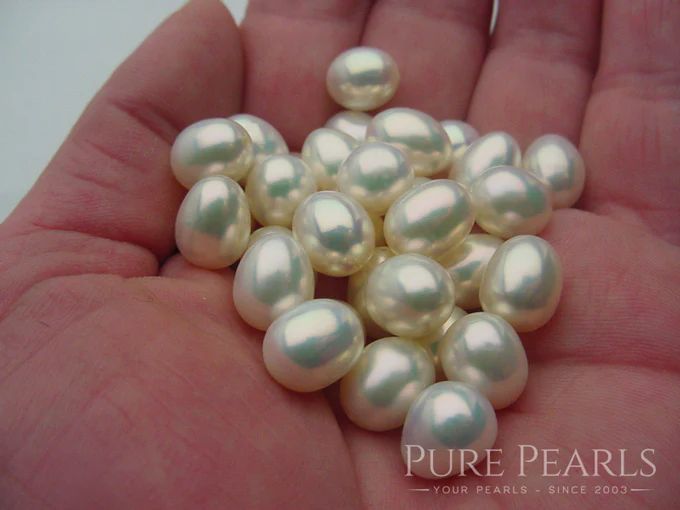What Does It Mean When A Robin’S Egg Is Blue?
Robins are a familiar sight in backyards and parks across North America. They are medium-sized songbirds with a reddish-orange breast and face. Robins build nests out of grass, sticks and mud, often on tree branches or gutters.
The female robin lays light blue eggs with dark speckles in the nest. A clutch is usually around 3-5 eggs. The coloration helps camouflage the eggs when the mother bird briefly leaves the nest.
Typical Robin Egg Color
The eggs of American robins are usually a light blue or bluish-green color. According to the Journey North Robin Facts page, “A. Blue. People have actually named a color ‘robin’s egg blue’ for the precise shade.” The specific hue can range from a pale turquoise blue to a brighter sky blue. But the most common color is the light blue that people associate with the eggs of robins.
The Hitchcock Center article “Cracking the mystery of how birds’ eggs are blue” states that “Yes, robins’ eggs are blue, but so are the eggs of many other local birds. Most of the thrushes in this area — the wood thrush, hermit thrush, Swainson’s thrush — lay pretty blue eggs.” So while the blue color is typical of robins, it is not unique to them. Many songbirds lay eggs in shades of blue.
Why Are Robin Eggs Blue?
The blue color of robin eggs is caused by pigments in the eggshell. Biliverdin is the main pigment responsible for the blue-green hue of robin eggs. This pigment is a byproduct of hemoglobin breakdown that is deposited in the eggshell as it develops in the mother robin’s oviduct. The more biliverdin deposited, the more intense blue-green the egg color will be.
In addition to pigmentation, the blue color of robin eggs results from how light refracts through the eggshell. The calcium carbonate composition of the shell acts as a filter that scatters light waves, bringing out the blue wavelengths more strongly. This effect enhances the blue color produced by the biliverdin pigment. The combination of pigment and light refraction is why robin eggs take on their characteristic blue coloration (Audubon).
Blue Eggs and Evolution
The blue color of robin eggs likely evolved as a form of camouflage and signaling. Birds that nest in the open, like robins, are vulnerable to predation. Eggs that blend in with their surroundings help conceal the nest from predators. The blue-green color of robin eggs matches the foliage and sky surroundings of the nest. This makes the eggs harder to spot by predators like crows or snakes.
Some research also suggests the blue-green color acts as a signal to the parent birds. The unique color helps the parents identify their own eggs in the nest. This may aid birds in rejecting foreign eggs from their nest that could belong to brood parasites. So the blue egg color evolved partly to hide the eggs and partly to help parent robins recognize their own eggs.
Sources:
https://www.forbes.com/sites/grrlscientist/2016/07/25/why-are-robins-eggs-blue/
https://www.hitchcockcenter.org/earth-matters/cracking-the-mystery-of-how-birds-eggs-are-blue/
Variations in Blue Color
Robin eggs come in a range of blue shades, from pale sky blue to a deeper cerulean. According to the Royal Society for the Protection of Birds, the most common robin egg color is “a greenish-blue.”1 However, robin eggs may also appear more blue-green or have a bluer tone. The exact shade can depend on individual variations between birds, diet, environment, and genetics.
While robin egg blue is the most recognizable shade, some robin eggs can look quite different. An albino robin will lay white eggs rather than blue. Rare genetic mutations can also lead to robins producing lighter blue, greenish, or brownish eggs rather than the typical vibrant blue.
Why Some Eggs Are Not Blue
Although blue is the typical color of robin eggs, there are some variations that occur naturally. Some robin eggs take on a more brownish or olive hue, rather than a bright blue. This brownish coloration is caused by a higher amount of biliverdin, a pigment found in bird eggshells.
Albino robin eggs can also occur, resulting in eggs that are white or very pale blue in color. Albino birds lack melanin pigments, which affects the coloration of their feathers and eggshells. The pale eggs laid by albino robins lack the biliverdin pigment that normally gives robin eggs their signature blue shade.
While blue is by far the most common, the natural color variations show that genetics and pigmentation can influence the final color of robin eggs. The color doesn’t seem to affect the health or development of the chicks inside.
Does the Color Matter?
The blue coloration of robin eggs does seem to play an important role. Research has found that blue eggs are stronger than eggs of other colors. The pigments biliverdin and biliverdin zinc chelate that produce the blue-green hue help reinforce the shell structure of the egg. This added strength aids in preventing cracking and breaking. Studies have shown that robin eggs with more saturated blue-green coloration are less likely to fail during incubation than paler eggs (source).
In addition to strength, the blue egg coloration may offer some protective benefits during incubation and development. Some research indicates that the biliverdin pigment in blue eggs filters out sunlight, shielding the developing embryo from harmful UV radiation and preventing overheating (source). This photoprotective effect could potentially improve hatching success.

Overall, the unique blue hue of robin eggs appears closely tied to their strength, incubation ability, and hatching rates. While more research is still needed, the coloration likely provides important benefits that aid in the reproductive success and fitness of robins.
Blue Eggs in Culture
The striking blue color of robins’ eggs has made them culturally significant across many societies. In mythology and folklore, the blue egg is often seen as a symbol of spring, fertility, and new life. For example, in Germany the first robin’s egg spotted was considered good luck.
Blue robin eggs have inspired many works of art. The vibrant blue is noticeable against the brown background of the nest, making the eggs visually appealing subjects for paintings and illustrations. Famous artists like Beatrix Potter and John James Audubon featured robins’ eggs in their nature studies. Decorative Easter eggs are also commonly dyed a similar robin’s egg blue.
The distinctive color even inspired the name of the web color “robin egg blue.” This specific shade of light blue takes its name from the egg color and is used in design for its calming effect. Culturally, the blue robin’s egg reminds us of the wonders of nature and represents the promise of new life each spring.
Threats to Blue Eggs
Despite their iconic nature, the beautiful blue eggs laid by robins face a number of threats in the modern world. Habitat loss is one of the primary dangers. As forests are cleared and wetlands drained, robins lose nesting spots and access to the insects and worms they feed on. Climate change also threatens robins’ breeding patterns and food sources. The warming temperatures cause insects to emerge earlier and can lead to mistimed migration and nesting for robins.
Pollution poses another hazard to robin eggs. Pesticides and other chemicals can contaminate the environment and be absorbed by the adult birds. The toxins are then deposited into the egg yolk, potentially damaging the developing chicks. Rodenticides used to control mice and rats may also inadvertently poison parent robins who ingest poisoned prey.
Other threats to blue robin eggs include competition for nesting sites with invasive species like European starlings as well as predation from cats, snakes, and predatory birds. Protecting robin habitat and minimizing pollution will give these beloved birds a better chance at successfully nurturing their vivid blue eggs through hatching season.
Conclusion
The characteristic blue color of robin eggs is a fascinating aspect of nature. As we’ve explored, the blue hue primarily comes from biliverdin, a pigment in the eggshell. This blue color likely evolved to help camouflage robin nests and eggs from predators. While blue is the most common robin egg color, variations can occur based on diet, genetics, and environment. The blue egg holds an important place in culture and folklore, representing springtime and new life.
While robins and their blue eggs continue to flourish across North America and Europe, some threats exist. Habitat loss, pesticides, climate change, and invasive species impact robin populations and reproduction. Protecting natural areas and limiting chemical use can help preserve the future of these beloved songbirds and their brilliant blue eggs.
The striking blue of a robin’s egg is an amazing example of evolution and adaptation. As we welcome another spring, take a moment to appreciate the beauty of nature found in something as small as a robin’s egg.




